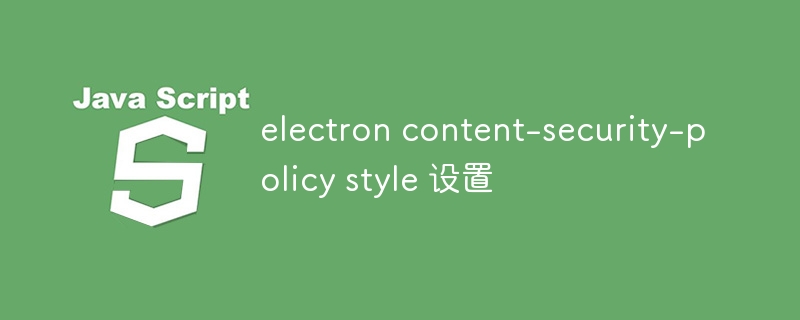電子內容-安全-策略風格設置
- DDD原創
- 2024-08-15 13:46:381096瀏覽
本文重點介紹 Electron 中樣式的內容安全策略(CSP)配置,Electron 是一個應用程式平台,允許開發人員使用 Web 技術建立跨平台桌面應用程式。本文討論了 'el

如何在 Electron 中為樣式配置內容安全策略(CSP)?
要為 Electron 中的樣式配置 CSP,可以使用 Electron .session.defaultSession.webRequest.onHeadersReceived 事件。收到請求的標頭時會發出此事件,允許您在將標頭髮送到伺服器之前修改標頭。 electron.session.defaultSession.webRequest.onHeadersReceived event. This event is emitted when a request's headers are received, allowing you to modify the headers before they are sent to the server.
To add a CSP header to a request, you can use the setHeader method on the responseHeaders object. For example, the following code adds a CSP header to all requests:
<code class="typescript">electron.session.defaultSession.webRequest.onHeadersReceived((details, callback) => {
details.responseHeaders['Content-Security-Policy'] = 'default-src \'self\'; style-src \'self\' https://unpkg.com; img-src \'self\' https://unpkg.com https://example.com;'
callback({responseHeaders: details.responseHeaders});
});</code>
What are the best practices for setting up a CSP for styles in an Electron application?
When setting up a CSP for styles in an Electron application, there are a few best practices to follow:
- Use a default-src directive to allow all requests from the same origin. This will ensure that all of your application's styles are loaded.
- Use a style-src directive to specify which origins are allowed to load styles. This will help to prevent cross-site scripting attacks.
- Use a nonce to prevent inline styles from being executed. A nonce is a random value that is generated on the server and included in the CSP header. This helps to ensure that only styles that are loaded from trusted sources can be executed.
Which browser sources are supported by Electron's CSP for styles?
Electron's CSP for styles supports the following browser sources:
-
'self': This source represents the application's own origin. -
'unsafe-inline': This source allows inline styles to be executed. -
'unsafe-eval': This source allows inline scripts to be executed. 'none'要將 CSP 標頭新增至請求,您可以使用
setHeader 方法responseHeaders 物件。例如,以下程式碼向所有請求添加 CSP 標頭:- 使用 default-src 指令允許來自同一來源的所有請求。 這將確保加載應用程式的所有樣式。 🎜使用 style-src 指令指定允許哪些來源載入樣式。 這將有助於防止跨站腳本攻擊。 🎜
-
使用隨機數字來防止內聯樣式nonce 是在伺服器上產生並包含在 CSP 標頭中的隨機值。這有助於確保只能執行從受信任來源載入的樣式。 🎜🎜🎜Electron 的樣式 CSP 支援哪些瀏覽器來源? 🎜🎜Electron 的樣式 CSP 支援以下瀏覽器來源:🎜
-
'self':此來源代表應用程式自己的來源。 🎜 -
'unsafe-inline':此來源允許執行內聯樣式。 🎜 - 'unsafe-eval':此來源允許執行內聯腳本。 🎜
-
'none':該來源不允許載入任何資源。 🎜🎜
-
以上是電子內容-安全-策略風格設置的詳細內容。更多資訊請關注PHP中文網其他相關文章!

